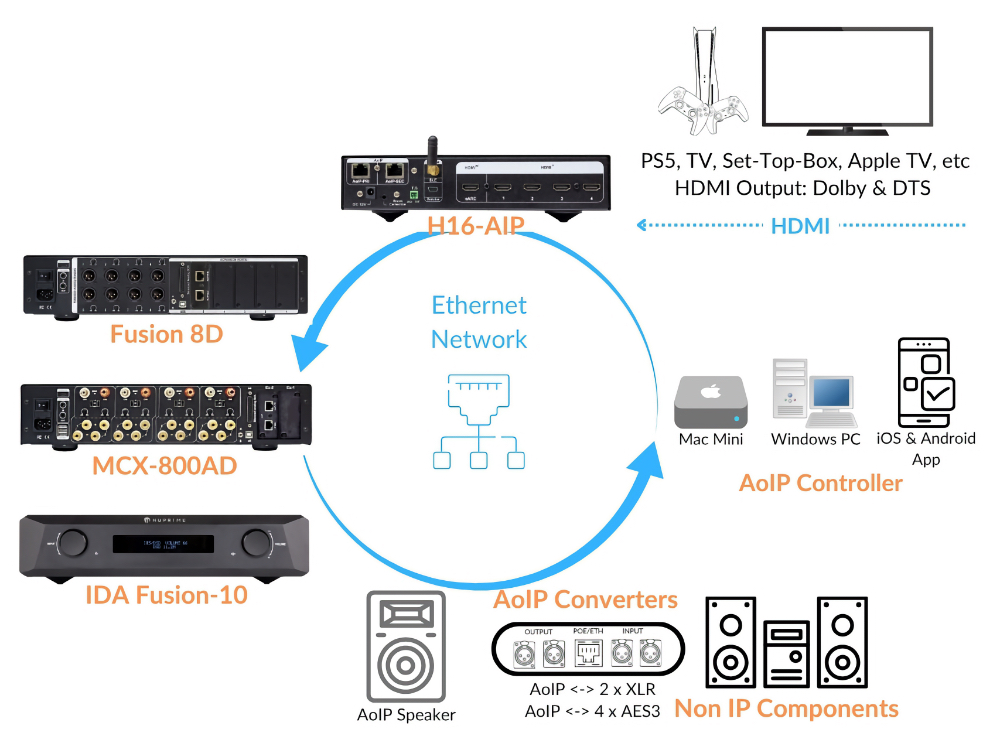
Audio over Internet Protocol (AoIP) Overview
Audio over Internet Protocol (AoIP) is a technology used for transmitting digital audio across standard IP networks, revolutionizing the way audio is distributed in various professional and consumer environments. This document outlines the evolution of AoIP, its core technologies, and its growing relevance in immersive and multi-channel audio systems.
Evolution of AoIP
AoIP has developed into a key technology for transmitting audio in high-quality, large-scale environments, from simple stereo setups to immersive multi-channel configurations. Initially, audio distribution relied on analog or digital point-to-point connections, but AoIP uses existing network infrastructure, allowing flexibility and scalability. Protocols such as AES67 have emerged as standards, supporting interoperability between devices from different manufacturers.
Key Technologies and Standards
AoIP protocols rely on several network standards to ensure reliable, low-latency audio transmission. Some of the key technical aspects include:
- AES67: A widely adopted standard for high-quality audio streaming, AES67 supports interoperability between different AoIP technologies. It operates over Layer 3 networks, enabling uncompressed audio to be transmitted over IP.
- PTPv2 (Precision Time Protocol): Provides sub-microsecond synchronization between devices, ensuring accurate timing across distributed systems.
- IGMP (Internet Group Management Protocol) and Multicast: Enables efficient distribution of audio streams to multiple devices.
- DiffServ QoS (Quality of Service): Ensures prioritization of audio traffic over the network to maintain consistent quality.
Advantages of AoIP
AoIP offers several benefits, particularly in professional audio environments:
- High Audio Quality: It supports uncompressed, high-resolution audio transmission. The highest sampling rate supported by AES67 is 192 kHz at a bit depth of 24 bits. This allows for high-resolution, uncompressed audio transmission over IP networks, making AES67 suitable for professional and high-end audio applications.
- Scalability: The ability to easily add more channels or devices without the need for additional cabling.
- Long Distances: Audio can be transmitted over long distances using standard Ethernet cables.
- Centralized Management: AoIP systems can be managed from a single point, simplifying configuration and control.
- Cost Efficiency: AoIP reduces the need for specialized cabling and hardware, making it a cost-effective solution.
Challenges of AoIP
Despite its benefits, AoIP presents some challenges:
- Network Management: AoIP systems require a network that is capable of handling audio at the OSI layer 3, which may require advanced knowledge and specialized equipment.
- Dedicated Computers: At least one computer is typically needed to manage AoIP I/O.
- Limited Support in High-End Equipment: Many existing audiophile-grade devices do not yet fully support AoIP, limiting its adoption in certain markets.
AoIP in Immersive Audio Systems
AoIP is ideal for immersive audio systems, where numerous audio channels need to be transmitted to various devices, such as speakers and processors. Its ability to handle multi-channel audio efficiently makes it a preferred solution for setups requiring flexibility and scalability.
In conclusion, AoIP represents the future of audio transmission, particularly in environments requiring high channel counts, flexibility, and centralized control. Its rapid scalability, coupled with high-quality audio performance, positions it as a cornerstone for both professional and high-end audio applications, particularly in immersive sound systems.
